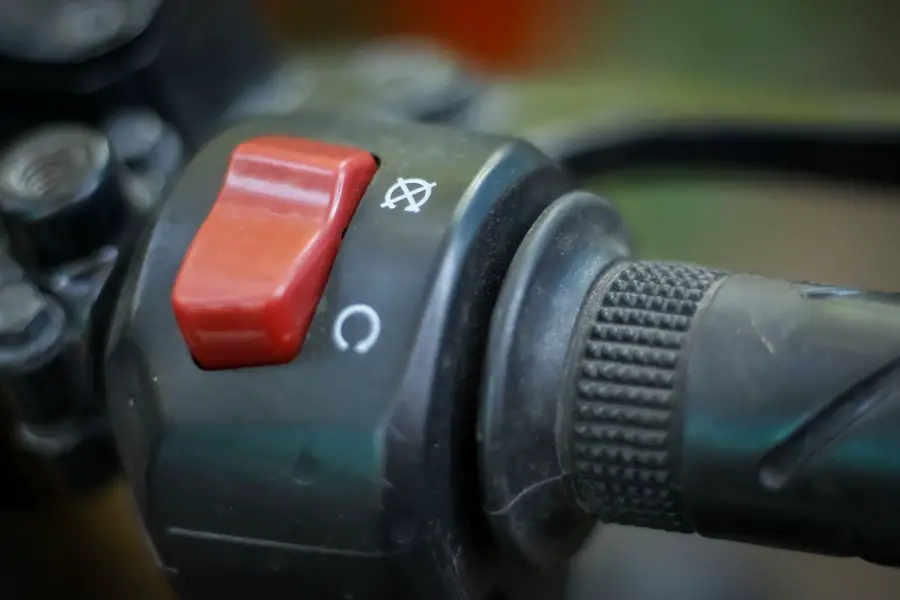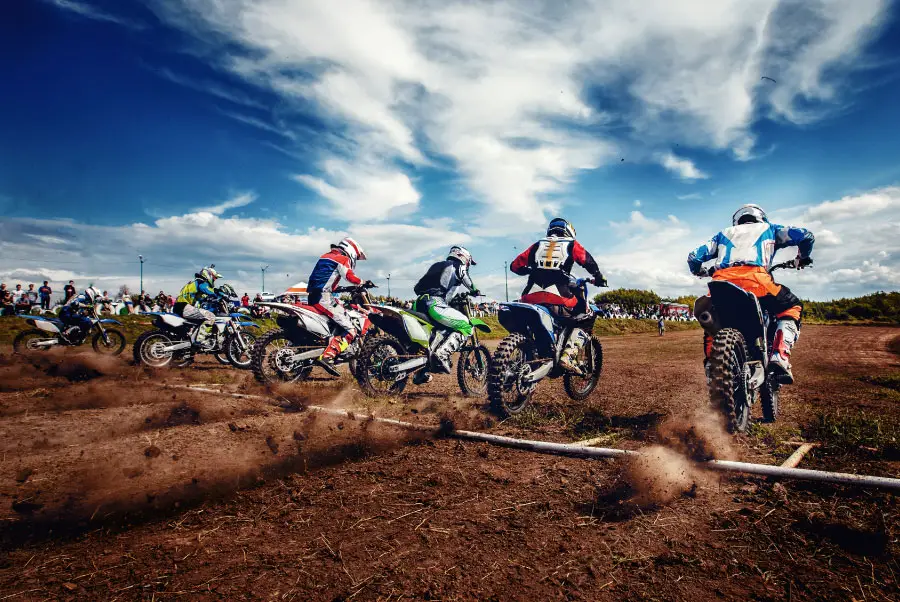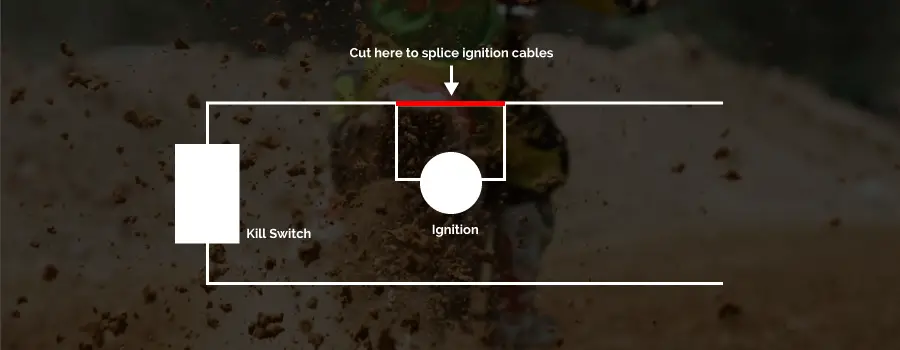
Many dirt bike models don’t come standard with an ignition. To get the bike going, you simply flip the kill switch off and kick the bike or press the electronic start button. Many riders would like an additional key ignition for their dirt bike, as it adds an extra layer of protection against casual theft of the bike.
If you intend to add an ignition to your dirt bike, then this article may help you get started in the fitment of the unit.
The steps to add an ignition to your dirt bike are straightforward if you have some understanding of bike wiring. Check your bike wiring diagram to locate the kill switch wires. Splice the ignition wires into the same wire on the kill switch. Secure the wires and mount the ignition to the handlebars.
These steps may seem rather basic, and while the process is not difficult, you will need some more detail on these steps to get the process right. Not only are these steps detailed below, but we also offer some tips on buying the right ignition for your bike.
Before we get into the steps to add an ignition to your bike, let us go over some of the tools and accessories you will need to gather to get the job done.
Tools And Accessories To Add An Ignition To Your Dirt Bike
Of course, you will need the new ignition switch for your bike and also, a few basic tools and other bits and pieces.
We recommend you have the following available before you start the job and begin cutting wires on your bike.
- Good quality electrical tape that is not going to come unstuck in a few days.
- Cable ties or zip ties to secure wires to your bike frame.
- Heat shrink tube to seal joins in wires from short circuits and moisture.
- Soldering Iron and solder to secure joins in wires. I prefer soldering joints in wires as opposed to connectors. The rough environment that dirt bikes are exposed to can cause connectors to become dislodged. Also, in this case, the wires need to be securely connected so they cannot just be unclipped. After all, the reason for ignition is to improve security!
- Screwdriver.
- Pliers.
- Wire cutters.
- Spare electrical wire in case you need to extend any wires.
- Digital Multi-meter. While a multimeter is not essential for the job, it makes the tracing of cables easier and is invaluable when troubleshooting problems!
Now that we have all the tools and bits and pieces for the fitment of the ignition, let’s get down to the job!
Check Wiring Diagram Of Your Bike In The Owner’s Manual
Knowledge is key to making this job simple and quick, hence consulting the electrical wiring diagram of your bike is a good place to start. If you do not have the owner’s manual, it is usually a simple matter to find one on the internet for your bike make and model.
The owner’s manual is useful because you can then know with confidence which wires you are dealing with, rather than having to trace wires to make sure.
Reading instructions manuals cannot be overrated, so it is wise also to examine the connection instructions that come with the ignition.
Essentially, an ignition will act as a second kill switch for your bike. As such, the ignition must be wired in series to the kill switch. This means that either the kill switch or the ignition will be able to kill the motor, but to start the bike, both the ignition and the kill switch must be switched on.
Wiring the ignition in this way is also works if you have an electric start as opposed to a kick start on your bike. The kill switch and the ignition will cut the electric circuit to the spark plug, which results in no spark and, hence, no combustion of the fuel, and the bike won’t run.
Locate the wires, usually two of them, that go to the kill switch. You will be splicing the ignition into only one of the wires to connect the ignition in series to the kill switch.
You may need to follow these wires back to an appropriate position close to where you will be mounting the ignition to make the connection easier with the length of the cables on the ignition. Otherwise, you will need to use the additional electrical wire to extend the ignition cables to the connection point.

Splice The Ignition Wire Into The Kill Switch Wire
Cut the wire that you have chosen that comes from the kill switch of the bike. Trim the outer insulation from both the cut ends of the wire, as you will be joining the wires from the ignition to these two wires.
Slide a heat shrink sleeve over both each of the cut ends. Use the soldering iron and solder one cable from the ignition to the one cut end of the cable and the other ignition cable to the other cut end of the kill switch wire. Make sure to connect the right cables from the ignition to the correct ends of the cut wire to make and break the circuit correctly when the key is turned.
You may need to consult the documentation that came with the ignition to get this right, or you can test the circuit with the multimeter to make sure it is correct.
Once the wires are soldered together, check that everything works as it should before closing up the joints and moving on to the last steps.
Once the correct functioning has been established, slide the heat shrink sleeve over the soldered joint on each wire. Use a heat source such as a lighter or a match to apply heat to the sleeve. The heat will cause the material to shrink around the soldered joint, effectively sealing it to protect against touching other wires of the chassis of the bike and shorting out.

Secure The Wiring and Mount the Ignition
Secure the wiring to the frame of the bike using the cable/zip ties and trim the edges of the ties with a wire cutter. It is important to secure the wires to protect them from catching on obstacles or being worn through by rubbing on the frame of the bike if not secured properly.
Mount the ignition according to the instructions provided, and in a location on the handlebars that is easy to access, but that won’t get in the way while you are riding.
The final part of the process is to re-check everything and test that the ignition works as expected. In other words, that the bike cannot be started unless the ignition and the kill switch are both on, and that the ignition will cut the motor when it is turned off with the key.
Why Are Ignitions Not Standard On Dirt Bikes?
Dirt bikes are generally built for recreational purposes off-road, so they are not intended to be parked on the street where there is a likelihood of them being stolen. That is not to say that theft will not occur while you are out for a day at your favorite off-road riding location.
When your dirt bike is not in use, it should be stored in a secure garage or other lockable structure. While this is not always the reality, dirt bike manufacturers operate on this principle and therefore don’t fit key ignitions to dirt bikes.
Many riders need to secure their bikes, since their situation may not be the norm. A keyed ignition is by no means a secure method of securing your bike, as it will only protect your bike from the inexperienced thief, and barely slow down a professional.
Therefore a key ignition is more a deterrent for the casual bad guy and should not be relied on to secure your bike on the street. Other products, such as clutch locks, have been developed by the industry to be a more secure method. Chains and locks are another alternative but are no guarantee against a professional felon.
Even if your methods to prevent the illicit starting of the bike work, a dirt bike is easily lifted by two people onto the back of a truck where they can take it to a location where they can work on disabling your security measures at their leisure.
That being said, we need to take whatever measures we can to deter criminals from taking our beloved dirt bikes, so any measure is better than nothing!
What Ignition Should You Buy For Your Dirt Bike?
If you intend to add an ignition to your dirt bike for security reasons, it makes sense to get the best unit possible. Fortunately, these ignitions are not expensive and will usually come in at under $50.
It is best to source an ignition that is intended for use on dirt bikes since dirt bikes operate in dirty conditions that other vehicles are not usually subjected to.
The best place to source an ignition is to speak to your local dirt bike accessory shop. They will typically carry a range of units to choose from.
One important aspect to check on is how the ignition will be mounted. Check the unit you intend to purchase and make sure it can be fitted securely to your dirt bike.
Conclusion
Now that we’ve taken you through the steps of how to add ignition to your dirt bike, it’s time to get your bike to the track!
Feel free to check out our article on “Can You Add an Electric Start to a Dirt Bike?.”
Happy dirt biking!


